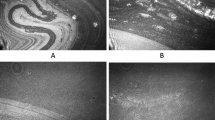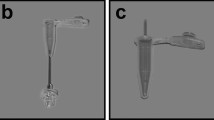Abstract
In 116 persons (67 men and 49 woman) the tear fluid of both eyes was collected using paper discs and once more after topical anaesthesia. After weighing the discs and eluting the tear fluid, the lysozyme content was measured using two immunological methods [radial immunodiffusion (RID) and rocket immuno-electrophoresis (RIE)] and a spectrophotometric assay. Standard curves were established with purified human lysozyme and egg-white lysozyme. In addition, albumin was determined in all the samples by rocket immuno-electrophoresis. All lysozyme assays showed a high degree of correlation, the spectrophotometric technique giving significantly lower values (compared with RID and RIE) when human lysozyme was used for standardization.
The lysozyme content of the tears did not correlate with the fluid uptake in the discs, but showed a significant decrease with age, which was abolished by topical anaesthesia. In contrast, albumin levels were dependent upon the weight and independent of the age of the patient.
It is suggested that the determination of albumin as a ‘reference protein’ might help in comparing the results of different tear sampling techniques used by various groups, which induce variable amounts of reflex tearing.
Zusammenfassung
Bei 116 Personen ohne Erkrankungen des äußeren Auges (67 Männer und 49 Frauen) wurde Trä nenflüßigkeit beider Augen mit Hilfe von Filterpapierscheibchen gewonnen. Dieser Vorgang wurde nach Applikation eines Lokalanästhetikums wiederholt. Nach dem Auswiegen und Eluieren der Tränenprobe wurde Lysozym mittels zweier immunologischer Methoden (der radialen Immundiffusion und der Immunelektrophorese) sowie einer spectrophotometrischen Technik bestimmt. Zur Erstellung der Standardkurven wurde gereinigtes menschliches, sowie Hühner-Eiweiß-Lysozym verwendet. Zusätzlich wurde Albumin mittels der Immunelektrophorese bestimmt.
Die Werte aller Lysozym-Bestimmungen zeigten eine hohe Korrelation, wobei jedoch die Mittelwerte der turbidimetrischen Technik signifikant unter jenen der immunologischen Methoden lagen, wenn humanes Lysozym zur Erstellung der Standardkurve verwendet wurde.
Similar content being viewed by others
References
Bijsterveld OP van (1969) Diagnostic tests in the sicca syndrome. Arch Ophthalmol 82: 10–14
Bijsterveld OP van (1973) The lysozyme agar diffusion test in the sicca syndrome. Ophthalmologica 167: 429–432
Boberg AJ (1956) On the corneal sensitivity. Acta Ophthalmol 34: 149–162
Bonavida B, Sapse AT (1968) Human tear lysozyme. II. Quantitative determination with standard Schirmer strips. Am J Ophthalmol 66: 70–76
Covey W, Perillie P, Finch SC (1971) The origin of tear lysozyme. Proc Soc Exp Biol Med 137: 1362–1363
Ensink FTE, Haeringen NJ van (1977) Pitfalls in the assay of human tear fluid. Ophthal Res 9: 366–373
Eylan E, Ronen D, Romano A, Smetana O (1977) Lysozyme tear level in patients with herpes simplex virus eye infection. Invest Ophthalmol Vis Sci 16: 850–853
Fleming A (1922) On a remarkable bacteriolitic element found in tissues and secretions. Proc Soc Lond (B) 93: 306–317
Friedberg I, Avigad G (1966) High lysozyme concentration and lysis of Micrococcus lysodeicticus. Biochem Biophys Acta 127: 532–535
Gillette TE, Allansmith MR, Greiner JV, Janusz M (1980) Histologic and immunohistologic comparison of main and accessory lacrimal tissue. Am J Ophthalmol 89: 724–730
Gillette TE, Greiner JV, Allansmith MR (1981) Immunohistochemical localization of human tear lysozyme. Arch Ophthalmol 99: 298–300
Hyper TJ (1980) Fluid uptake in Schirmer papers and its relevance to their employment in tear collection for lysozyme tests. Br J Ophthalmol 64: 696–699
Jolles G, Jolles P (1967) Human tear and human milk lysozyme. Biochemistry 6: 411–417
Jones LT (1966) The lacrimal secretory system and its treatment. Am J Ophthalmol 62: 47–60
Jordan A, Baum J (1980) Basic tear flow. Does it exist? Ophthalmology 87: 920–930
Lamberts DW, Foster CS, Perry HD (1979) Schirmer test after topical anesthesia and the tear meniscus height in normal eyes. Arch Ophthalmol 97: 1082–1085
Laurell CB (1966) Quantitative estimation of proteins by electrophoresis in agarose gel containing antibodies. An Biochem 15: 45–54
Luger T, Kokoschka EM, Sagaster P, Miksche M (1979) Serum lysozyme levels in patients with solid tumors. Oncology 36: 15–18
Mackie IA, Seal DV (1976) Quantitative tear lysozyme assay in units of activity per microlitre. Br J Ophthalmol 60: 70–74
Mackie IA, Seal DV, Pescod JM (1977) Beta-adrenergic receptor blocking drugs: tear lysozyme and immunological screening for adverse reaction. Br J Ophthalmol 61: 354–359
Mancini G, Carbonara AO, Heremans JF (1965) Immunochemical quantitation of antigens by single radial immunodiffusion. Immunochemistry 2: 235–254
McEwen WK, Kimura SJ (1955) Filter-paper electrophoresis of tears. I. Lysozyme and its correlation with keratoconjunctivitis sicca. Am J Ophthalmol 39: 200–202
Meyer K (1948) Mucopolysaccharides and mucoids of ocular tissues and their enzymatic hydrolysis. In: Sorsby A (ed) Modern trends in ophthalmology. Butterworth, London, pp 71–78
Millodot M (1977) The influence of age on the sensitivity of the cornea. Invest Ophthalmol Vis Sci 16: 240–242
Milton LR (1965) Paralimbal ring keratitis and absence of lysozyme in lupus erythematosus. Am J Ophthalmol 60: 532
Norm MS (1973) Conjunctival sensitivity in normal eyes. Acta Ophthalmol 51: 58–66
Osserman EF, Lawlor DP (1966) Serum and urinary lysozyme (muramidase) in monocytic and monomyelocytic leukemia. J Exp Med 124: 921–952
Peeters TL, Vantrappen GR (1977) Factors influencing lysozyme determination by the lysoplate method. Clinica Chim Acta 74: 217–225
Pietsch RL, Pearlman ME (1973) Human tear lysozyme variables. Arch Ophthalmol 90: 94–99
Prockop DJ, Davidson WD (1964) A study of urinary and serum lysozyme in patients with renal disease. New Engl J Med 270: 269–271
Regan E (1950) The lysozyme content of tears. Am J Ophthalmol 33: 600–605
Ronen D, Eylan E, Romano A Stein R, Modan M (1975) A spectrophotometric method for quantitative determination of lysozyme in human tears: description and evaluation of the method and screening of 60 healthy subjects. Invest Ophthalmol 14: 479–484
Selinger DS, Selinger RC, Reed WP (1979) Resistance to infection of the external eye: the role of tears. Surv Ophthalmol 24: 33–38
Sen DK, Sarin GS (1980) Immunoassay of human tear lysozyme. Am J Ophthalmol 90: 715–718
Shugar D (1952) The measurement of lysozyme activity and the ultraviolet inactivation of lysozyme. Biochem Biophys Acta 8: 303–309
Thompson R, Gallardo E (1936) The concentration of lysozyme in the tears in acute and chronic conjunctivitis. With a note on the source of lysozyme of tears. Am J Ophthalmol 19: 684–685
Walsh FB, Hoyt WF (1969) Clinical Neuro-Ophthalmology. Williams and Wilkins Co. p. 555
Weeke B (1973) Rocket immunoelectrophoresis. Scan J Immunol 2. Suppl 1, pp 36–46
Author information
Authors and Affiliations
Additional information
At present research fellow at the Francis I. Proctor Foundation for Research in Ophthalmology, supported by a grant from the Max Kade Foundation
Rights and permissions
About this article
Cite this article
Grabner, G., Formanek, I., Dorda, W. et al. Human tear lysozyme. Graefe's Arch Clin Exp Ophthalmol 218, 265–270 (1982). https://doi.org/10.1007/BF02175895
Received:
Issue Date:
DOI: https://doi.org/10.1007/BF02175895




